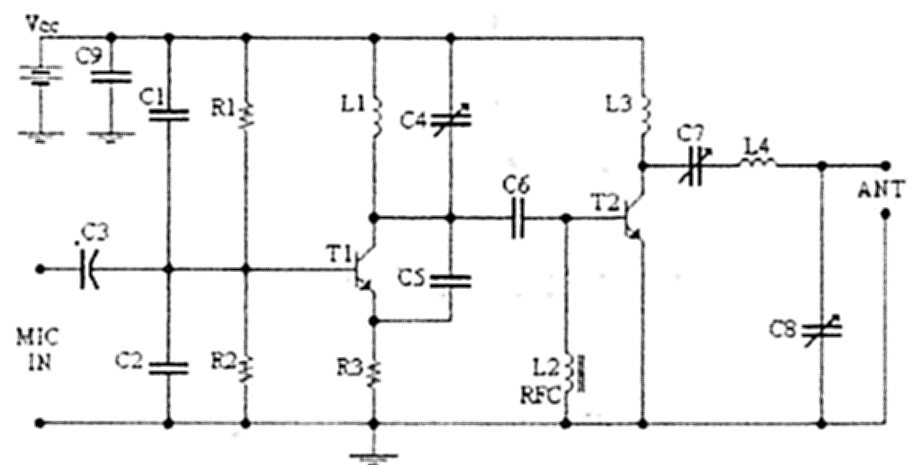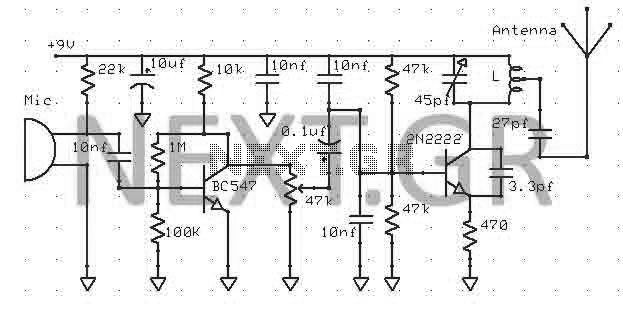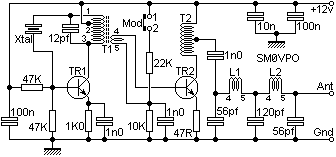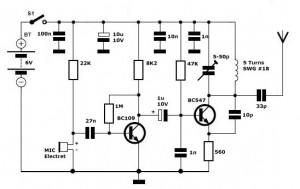
Long-Range IR Transmitter
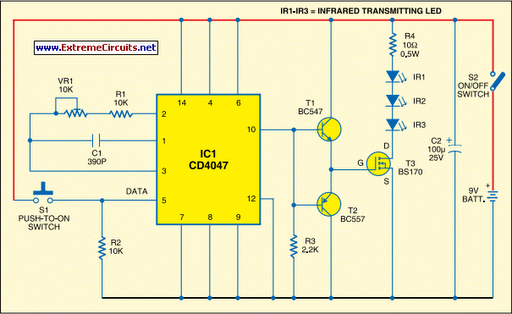
Most IR remotes operate reliably within a range of 5 meters. The complexity of the circuit increases when designing an IR transmitter for reliable operation over a longer range, such as 10 meters. To double the range from 5 meters to 10 meters, the transmitted power must be increased fourfold. For a highly directional IR beam, a suitable option is to use an IR laser pointer as the signal source. Laser pointers are widely available in the market. However, due to the narrow beam produced by the laser pointer, extra care must be taken, as even a slight movement of the device can alter the beam orientation and result in loss of contact. A simple circuit that provides a significant range utilizes three infrared transmitting LEDs (IR1 through IR3) arranged in series to enhance the radiated power. To further increase directivity and power density, the IR LEDs can be mounted within the reflector of a flashlight. To improve circuit efficiency, a MOSFET (BS170) is employed as a switch instead of a standard transistor. To prevent any voltage dips during the on/off operations, a 100 µF reservoir capacitor (C2) is placed across the battery supply. This capacitor is particularly beneficial when the IR transmitter is powered by regular batteries, as it supplies extra charge during switching operations. Given that the MOSFET has significant capacitance across its gate-source terminals, a special drive arrangement using an NPN-PNP Darlington pair (BC547 and BC557 as emitter followers) is implemented to mitigate distortion of the gate drive input. The data to be transmitted (CMOS-compatible) is used to modulate a 38 kHz frequency generated by the CD4047 (IC1). In the provided circuit, a tactile switch (S1) is used for modulating and transmitting the IR signal. The circuit should be assembled on a general-purpose PCB, with switch S2 used for power on/off control. Commercially available IR receiver modules, such as the TSOP1738, can be utilized for efficient reception of the transmitted IR signals.
The described IR transmitter circuit is designed to achieve extended operational range and effective signal transmission. The use of three infrared LEDs in series significantly amplifies the emitted power, allowing for reliable communication over longer distances. The choice of a MOSFET as a switching element enhances the efficiency of the circuit, as MOSFETs typically have lower on-resistance compared to bipolar junction transistors, resulting in reduced power loss during operation.
The incorporation of a 100 µF capacitor is a critical design feature, as it provides stability to the power supply during rapid switching events. This is particularly important in battery-operated devices, where voltage fluctuations can lead to erratic behavior. By ensuring a steady voltage supply, the circuit can maintain consistent performance, even under varying load conditions.
The use of a Darlington pair for driving the MOSFET gate is an effective strategy to achieve high input impedance and low output impedance. This configuration minimizes the loading effect on the preceding circuit stage, ensuring that the modulation signal is accurately transmitted to the MOSFET gate without distortion. The modulation of the 38 kHz frequency by the data input allows for efficient encoding of the transmitted information, making the system suitable for various remote control applications.
Overall, this IR transmitter circuit design is an excellent solution for applications requiring long-range infrared communication while maintaining high efficiency and reliability. The integration of commercially available components simplifies the assembly process and enhances the accessibility of the design for hobbyists and professionals alike.Most of the IR remotes work reliably within a range of 5 metres. The circuit complexity increases if you design the IR transmitter for reliable operation over a longer range, say, 10 metres. To double the range from 5 metres to 10 metres, you need to increase the transmitted power four times.
If you wish to real i se a highly directional IR beam ( very narrow beam), you can suitably use an IR laser pointer as the IR signal source. The laser pointer is readily available in the market. However, with a very narrow beam from the laser pointer, you have to take extra care, lest a small jerk to the gadget may change the beam orientation and cause loss of contact. Here is a simple circuit that will give you a pretty long range. It uses three infrared transmitting LEDs (IR1 through IR3) in series to increase the radiated power. Further, to increase the directivity and so also the power density, you may assemble the IR LEDs inside the reflector of a torch.
For increasing the circuit efficiency, a MOSFET (BS170) has been used, which acts as a switch and thus reif a transistor were used. To avoid any dip during its on`/off` operations, a 100 F reservoir capacitor C2 is used across the battery supply.
Its advantage will be more obvious when the IR transmitter is powered by ordinary batteries. Capacitor C2 supplies extra charge during switching on` operations. As the MOSFET exhibits large capacitance across gate-source terminals, a special drive arrangement has been made using npn-pnp Darl ington pair of BC547 and BC557 (as emitter followers), to avoid distortion of the gate drive input. Data (CMOS-compatible) to be transmitted is used for modulating the 38 kHz frequency generated by CD4047 (IC1).
However, in the circuit shown here, tactile switch S1 has been used for modulating and transmitting the IR signal. Assemble the circuit on a general-purpose PCB. Use switch S2 for power on`/off` control. Commercially available IR receiver modules (e. g. , TSOP1738) could be used for efficient reception of the transmitted IR signals. 🔗 External reference
The described IR transmitter circuit is designed to achieve extended operational range and effective signal transmission. The use of three infrared LEDs in series significantly amplifies the emitted power, allowing for reliable communication over longer distances. The choice of a MOSFET as a switching element enhances the efficiency of the circuit, as MOSFETs typically have lower on-resistance compared to bipolar junction transistors, resulting in reduced power loss during operation.
The incorporation of a 100 µF capacitor is a critical design feature, as it provides stability to the power supply during rapid switching events. This is particularly important in battery-operated devices, where voltage fluctuations can lead to erratic behavior. By ensuring a steady voltage supply, the circuit can maintain consistent performance, even under varying load conditions.
The use of a Darlington pair for driving the MOSFET gate is an effective strategy to achieve high input impedance and low output impedance. This configuration minimizes the loading effect on the preceding circuit stage, ensuring that the modulation signal is accurately transmitted to the MOSFET gate without distortion. The modulation of the 38 kHz frequency by the data input allows for efficient encoding of the transmitted information, making the system suitable for various remote control applications.
Overall, this IR transmitter circuit design is an excellent solution for applications requiring long-range infrared communication while maintaining high efficiency and reliability. The integration of commercially available components simplifies the assembly process and enhances the accessibility of the design for hobbyists and professionals alike.Most of the IR remotes work reliably within a range of 5 metres. The circuit complexity increases if you design the IR transmitter for reliable operation over a longer range, say, 10 metres. To double the range from 5 metres to 10 metres, you need to increase the transmitted power four times.
If you wish to real i se a highly directional IR beam ( very narrow beam), you can suitably use an IR laser pointer as the IR signal source. The laser pointer is readily available in the market. However, with a very narrow beam from the laser pointer, you have to take extra care, lest a small jerk to the gadget may change the beam orientation and cause loss of contact. Here is a simple circuit that will give you a pretty long range. It uses three infrared transmitting LEDs (IR1 through IR3) in series to increase the radiated power. Further, to increase the directivity and so also the power density, you may assemble the IR LEDs inside the reflector of a torch.
For increasing the circuit efficiency, a MOSFET (BS170) has been used, which acts as a switch and thus reif a transistor were used. To avoid any dip during its on`/off` operations, a 100 F reservoir capacitor C2 is used across the battery supply.
Its advantage will be more obvious when the IR transmitter is powered by ordinary batteries. Capacitor C2 supplies extra charge during switching on` operations. As the MOSFET exhibits large capacitance across gate-source terminals, a special drive arrangement has been made using npn-pnp Darl ington pair of BC547 and BC557 (as emitter followers), to avoid distortion of the gate drive input. Data (CMOS-compatible) to be transmitted is used for modulating the 38 kHz frequency generated by CD4047 (IC1).
However, in the circuit shown here, tactile switch S1 has been used for modulating and transmitting the IR signal. Assemble the circuit on a general-purpose PCB. Use switch S2 for power on`/off` control. Commercially available IR receiver modules (e. g. , TSOP1738) could be used for efficient reception of the transmitted IR signals. 🔗 External reference
